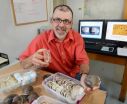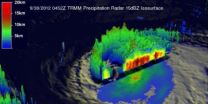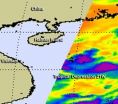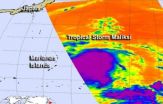(Press-News.org) PHOENIX -- A new Mayo Clinic study confirms the use of smartphones medical images to evaluate stroke patients in remote locations through telemedicine. The study, the first to test the effectiveness of smartphone teleradiology applications in a real-world telestroke network, was recently published in Stroke, a journal of the American Heart Association.
"Essentially what this means is that telemedicine can fit in our pockets," says Bart Demaerschalk, M.D., professor of Neurology, and medical director of Mayo Clinic Telestroke. "For patients this means access to expertise in a timely fashion when they need it most, no matter what emergency room they may find themselves."
Mayo Clinic was the first medical center in Arizona to do pioneering clinical research to study telemedicine to serve patients with stroke in non-urban settings. Today, Mayo Clinic is the hub in a network of 12 other spoke centers, all but one in Arizona. In telestroke care, the use of telemedicine platforms or robots located in a rural hospital lets a stroke patient be seen in real time by a neurology specialist who typically is working from a desktop or laptop computer in Phoenix. The Mayo Clinic stroke neurologist, whose face appears on a computer screen, consults with emergency room physicians at the rural sites and evaluates the patient.
Patients showing signs of stroke can be examined by the neurologist who can also view scans of the patient's brain to detect possible damage from a hemorrhage or blocked artery. If necessary patients can be administered clot-busting medications within the narrow window of time necessary to minimize permanent injury to the brain. The study compared the quality of medical images using a particular smartphone application to the same types of information and images typically viewed via desktop computers. Mayo Clinic neurologists worked with emergency physicians and radiologists at Yuma Regional Medical Center to compare brain scan images from 53 patients who came to that medical center with stroke.
The scans were reviewed by radiologists in Yuma and a separate adjudication panel of stroke neurologists to determine the level of agreement between these traditional interpretation routes and new images and scans on smartphones interpreted by telestroke doctors. The study shows there was a high level of agreement (92 to 100 percent) among all the reviewers over the most important radiological features.
"Smartphones are ubiquitous, they are everywhere," Dr. Demaerschalk says. "If we can transmit health information securely and simultaneously use the video conferencing capabilities for clinical assessments, we can have telemedicine anywhere, which is essential in a state like Arizona where more than 40 percent of the population doesn't have access to immediate neurologic care."
The study was funded by the Arizona Department of Health Services and the technology and technical assistance was provided by Calgary Scientific, the maker of ResolutionMD.
The Mayo Clinic Telestroke Network includes hospitals in Kingman, Flagstaff, Parker, Cottonwood, Show Low, Globe, Yuma, Bisbee, Casa Grande, Tuba City and Phoenix, all in Arizona; and a hospital in St. Joseph, Mo. To date, more than 1,000 emergency consultations have taken place for stroke between Mayo Clinic stroke neurologists and physicians at the spoke centers. Such comprehensive evaluation techniques lead to appropriate life-saving treatment for stroke, and have resulted in significant cost reductions by not requiring ground or air ambulance transfer of the patient to another medical center.
###
About Mayo Clinic
Mayo Clinic is a nonprofit worldwide leader in medical care, research, and education for people from all walks of life. For more information, visit www.mayoclinic.org/about/ and www.mayoclinic.org/news.
END
COLUMBUS, Ohio – Taking enough omega-3 fatty acid supplements to change the balance of oils in the diet could slow a key biological process linked to aging, new research suggests.
The study showed that most overweight but healthy middle-aged and older adults who took omega-3 supplements for four months altered a ratio of their fatty acid consumption in a way that helped preserve tiny segments of DNA in their white blood cells.
These segments, called telomeres, are known to shorten over time in many types of cells as a consequence of aging. In the study, lengthening ...
EAST LANSING, Mich. — Increasingly, U.S. firms are moving or considering moving their manufacturing operations back to domestic soil from overseas, finds a new study co-authored by a Michigan State University supply chain expert.
Fueling the trend are rising labor costs in emerging countries, high oil prices and increasing transportation costs, global risks such as political instability and other factors, said Tobias Schoenherr.
"Going overseas is not the panacea that it was thought of just a decade or so ago," said Schoenherr, assistant professor in MSU's top-ranked ...
AMES, Iowa – Two Iowa State University graduate students are just back from the Gulf of Maine with another big catch of clam shells.
Shelly Griffin and Madelyn Mette recently boarded a lobster boat, dropped a scallop dredge into 30 meters of ocean water and pulled up load after load of Arctica islandica.
"These are the clams that end up in clam chowder," said Alan Wanamaker, an assistant professor of geological and atmospheric sciences in the College of Liberal Arts and Sciences. Wanamaker studies paleoclimatology, the variations and trends of past climates and environments, ...
VIDEO:
Dr. Amir Toor from Virginia Commonwealth University Massey Cancer Center's Bone Marrow Transplant program explains a recent clinical trial evaluating a new therapy for multiple myeloma that harnesses the power...
Click here for more information.
Richmond, Va. – (October 1, 2012) – A novel therapy in the early stages of development at Virginia Commonwealth University Massey Cancer Center shows promise in providing lasting protection against the progression of multiple ...
Bethesda, MD (Oct. 1, 2012) — Patients at average risk of colorectal cancer who have a clean colonoscopy do not need to repeat the test for 10 years. This and many other practical recommendations for cancer prevention were issued in "Guidelines for Colonoscopy Surveillance After Screening and Polypectomy,"1 a consensus update issued by the U.S. Multisociety Task Force on Colorectal Cancer.
Colorectal cancer is preventable when precancerous polyps (growths) are found and removed before they turn into cancer. Screening for average risk patients is recommended to begin ...
MINNEAPOLIS / ST. PAUL (10/01/2012) —New genome editing technologies developed at the University of Minnesota for use on livestock will allow scientists to learn more about human diseases.
The genomic technique, known as TALENS, is described in a report published today in the scientific journal Proceedings of the National Academy of Sciences. The technique is cheaper and faster than previous technologies that allow scientists to genetically modify livestock animals; the animals are used to learn more about human diseases, which in turn can help researchers develop cures. ...
"Betcha can't eat just one!" For obese people trying to lose weight, the Lays potato chip advertising slogan hits a bit too close to home as it describes the daily battle to resist high calorie foods.
But new research by Terry Davidson, director of American University's Center for Behavioral Neuroscience, indicates that diets that lead to obesity—diets high in saturated fat and refined sugar—may cause changes to the brains of obese people that in turn may fuel overconsumption of those same foods and make weight loss more challenging.
"It is a vicious cycle that may ...
NASA satellites continue to watch the long-lived Nadine in the eastern Atlantic. Today, Oct. 1, NASA satellite data revealed that Nadine has weakened from a hurricane and is now a tropical storm.
Over the weekend of Sept. 29 and 30, Hurricane Nadine dramatically rebounded. On September 19, 2012 Nadine appeared to be dissipating quickly and was expected to become post-tropical but after over a week of meandering near the Azores, Nadine sprang to life again as a hurricane on Friday September 28, 2012.
NASA's Tropical Rainfall Measuring Mission (TRMM) satellite's path ...
The twenty-first tropical depression of the northwestern Pacific Ocean was born as a NASA satellite flew overhead on Oct. 1, capturing its "baby picture" in infrared light.
On Monday, Oct. 1 at 1500 UTC (11 a.m. EDT), Tropical Depression 21W (TD21W) had maximum sustained winds near 25 knots. It was centered about300 nautical miles south of Hong Kong, near 17.4 North latitude and 114.8 East longitude. TD21W has tracked northward at 5 knots and is expected to curve to the northwest and west.
On Oct. 1, 2012, infrared imagery from the Atmospheric Infrared Sounder (AIRS) ...
The western North Pacific is in full swing, tropically speaking and NASA observed the birth of Tropical Storm Maliksi on Sept. 30. NASA's Aqua satellite captured an infrared image of the storm when it was a depression and revealed a large area of powerful thunderstorms around its center that hinted at its strengthening.
Tropical Storm Maliksi formed from the twentieth tropical depression of the western North Pacific typhoon season. Tropical Depression 20W formed on Sept. 20 about 305 nautical miles from Guam near 16.3 North and 149.0 East. It is moving to the north-northwest ...




